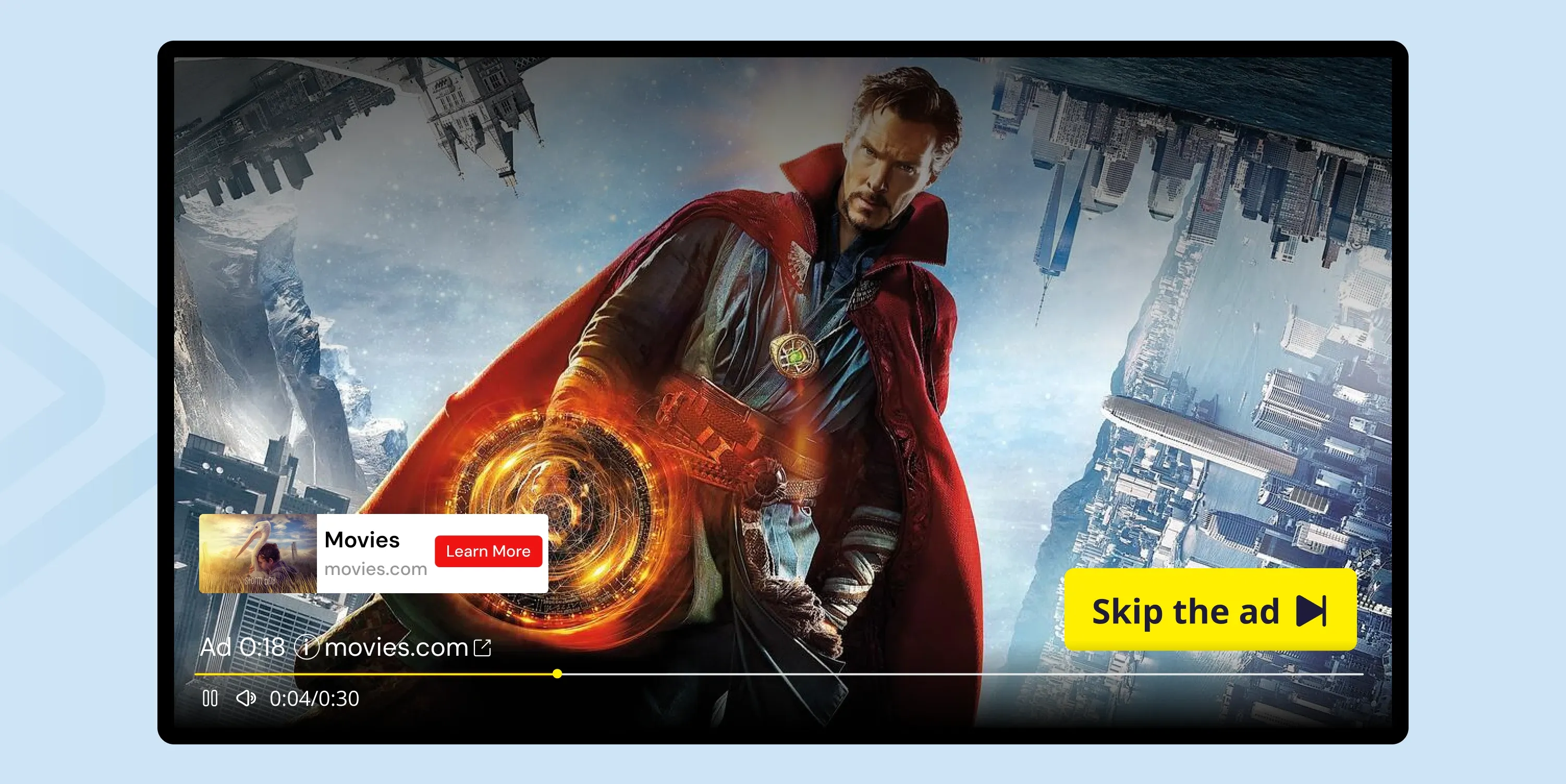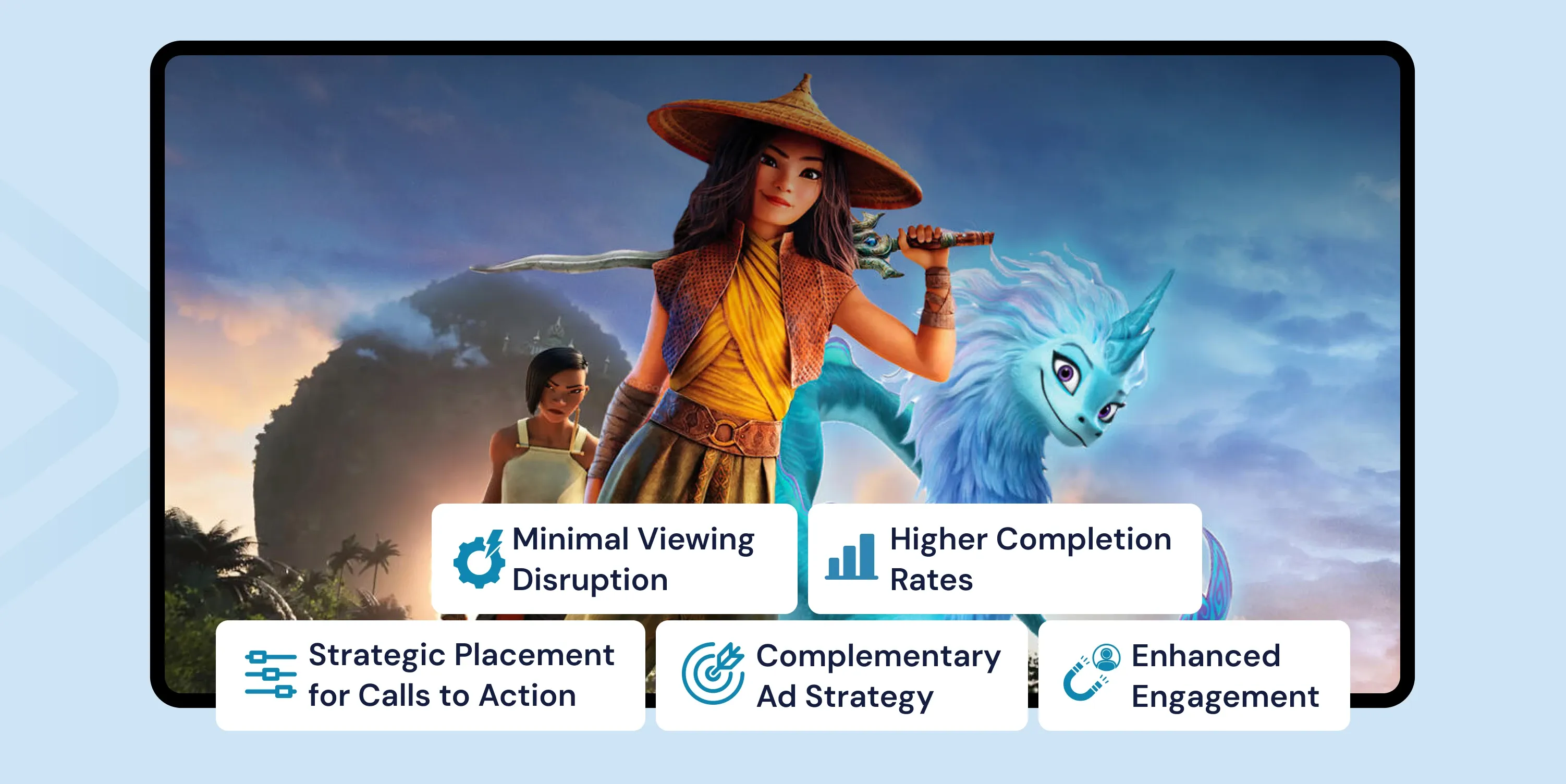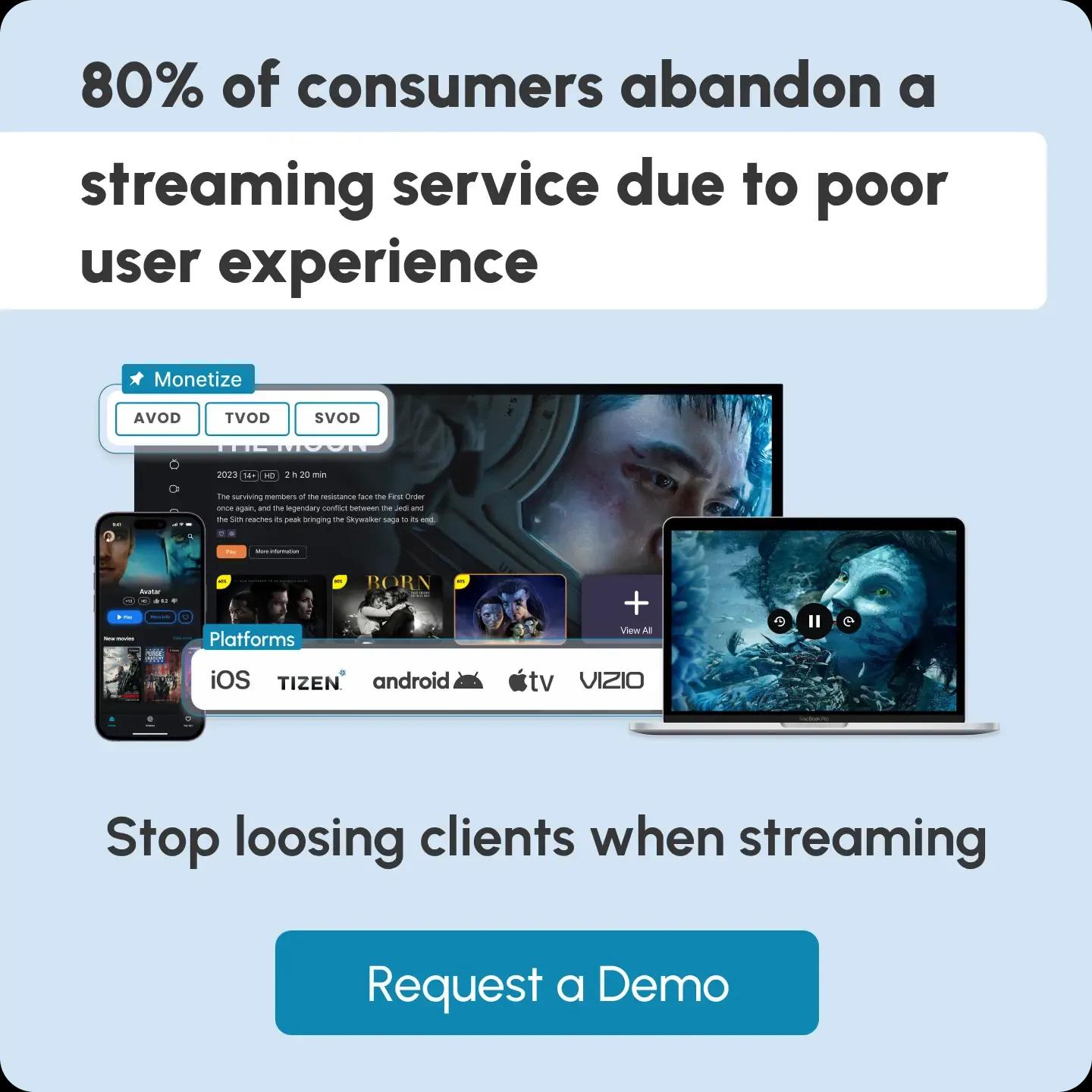
Post Roll Ads – Boost Engagement After Playback
Post-roll ads create a non-intrusive opportunity to engage audiences at a natural transition point. This makes them a valuable component in your AVOD (advertising video on demand) monetization strategy.
Whether you're a content creator looking to diversify revenue streams or a TV or hospitality marketer looking for just the right place to stream your ad, we’ll show you how to leverage post-roll ads.
 Let’s learn about the post-roll ads!
Let’s learn about the post-roll ads!
Key Takeaways
- Post-roll ads appear after content ends, creating an opportunity to engage viewers when they've finished watching their selected content.
- These ads offer strategic benefits for OTT platforms and live streaming services, with minimal disruption to the viewing experience.
- Effective implementation of post-roll ads can increase viewer retention and boost OTT monetization opportunities for revenue growth.
- Advanced technology stacks enable adaptive delivery of post-roll ads across various streaming platforms.
- Overcoming viewer drop-off challenges is possible with strategic placement and engaging ad content.
What is a Post-Roll Ad?
Post-roll ads are short video advertisements that play after the main content has concluded.
Unlike pre-roll ads, which appear before content, or mid-roll ads, which interrupt viewing (often frustrating viewers), post-roll video ads wait until viewers have finished watching their selected content. This placement creates a unique opportunity to engage with viewers without disrupting their primary content experience.
Post-roll ads are used across various digital platforms, including…
- OTT (Over-the-Top) broadcasting
- Social media
- Video-sharing websites
Note for Advertisers: Post-roll ads offer a final touchpoint to reinforce your message, ensuring that engaged audiences receive a call to action at the most opportune moment. Given that post-roll ads only appear after the main content, they enable more organic ad integration, thereby reducing viewer frustration and ad fatigue.
Placement in Content
Post-roll ads play after viewers have finished watching their chosen content, making them less intrusive than pre-roll or mid-roll formats. Viewers who finish a video may be more receptive to additional messaging, making these ads effective for promotions, calls to action, or recommending related content.
Note: This is particularly valuable for platforms that rely on user retention and engagement as part of their monetization strategy.
The strategic placement of post-roll ads ensures that advertisers reach viewers who are already invested in the content. This high engagement level increases the likelihood of ad retention, leading to improved conversion rates.
Since post-roll ads do not interfere with the main content, they also contribute to a more seamless user experience.
User Behavior and Post-Roll Ads
While pre-roll video ads aim to capture attention when viewers are eager to start watching, post-roll ads engage viewers during the natural pause after viewing.
Some user behavior studies suggest that viewers who watch a video till the end are more likely to engage with ads. According to an aList article, “65% of people watch post-roll ads to completion,” while 76% of viewers “skip pre-roll ads simply because they had become conditioned to do so.”
Post-roll ads appear when the viewer is more open to receiving additional information. This psychological aspect makes post-roll ads effective for driving deeper audience engagement and encouraging user actions (downloading your app, following a social media page, watching another video, or subscribing to a premium service).
Note for Advertisers: By aligning ad content with user interests, you can leverage post-roll placements to foster long-term customer relationships.
5 Benefits of Post-Roll Ads
 Post-roll ads offer several distinct advantages for content creators and streaming platforms:
Post-roll ads offer several distinct advantages for content creators and streaming platforms:
1. Minimal Viewing Disruption
Since post-roll ads play after the main content has finished, they don't interrupt the viewer's experience, creating a more positive impression compared to mid-roll interruptions. This compromise respects the viewer's experience while still delivering monetization opportunities.
2. Higher Completion Rates
Viewers who stay for post-roll ads often watch them to completion, providing advertisers with a greater chance of getting their message across.
3. Strategic Placement for Calls to Action
The position after content makes post-roll ads ideal for conversions, subscriptions, or encouraging viewers to watch related content.
4. Complementary Ad Strategy
Post-roll ads are effective when combined with pre-roll and other formats as part of a comprehensive ad strategy, creating multiple touchpoints throughout the viewing experience.
5. Enhanced Engagement
The natural transition point after content completion provides an opportunity for more interactive ad experiences that viewers might be more willing to engage with.
How Post-Roll Ads Work in OTT and Live Streaming
The insertion of post-roll ads into streaming content relies on sophisticated technology and seamless processes. For OTT platforms and live streaming services, the ad insertion process typically involves several key components:
Ad Insertion Process
In OTT environments, post-roll ads are typically inserted through server-side ad insertion (SSAI) or client-side ad insertion (CSAI). SSAI stitches ads directly into the content stream, creating a seamless viewing experience with minimal buffering. CSAI, on the other hand, relies on the viewer's device to request and display ads at designated points.
For live streaming advertising, post-roll ads can be strategically placed at natural breaks in content, such as at the end of a live event or broadcast. This requires real-time decision-making systems that can quickly determine when to insert the ad based on content signals.
Note: post-roll ads shown at the end of a stream depend heavily on how many viewers stay until the end of the live stream, making their strategic placement crucial.
Technology Stack
The technology stack for post-roll ad implementation includes:
- Ad servers, which store and deliver ads to viewers based on targeting parameters.
- Compatible video players that support ad insertion at designated markers.
- Ad Decision systems, to show to which viewers based on sophisticated targeting parameters.
- Analytics platforms, such as tools that track viewer engagement, completion rates, and conversion metrics.
- Dynamic ad insertion (DAI) tools that allow for real-time personalization and targeting of post-roll ads.
- Demand-side platforms (DSPs) enable programmatic buying of ad inventory across multiple OTT platforms.
Adaptive Delivery
Modern post-roll ad systems employ adaptive delivery techniques to optimize the viewing experience:
- Bandwidth Optimization: Ads are delivered at appropriate quality levels based on the viewer's available bandwidth, ensuring smooth playback even in variable network conditions.
- Device Compatibility: Formats are automatically adjusted to suit various devices, from mobile phones to smart TVs, recognizing that OTT content is consumed across multiple platforms.
- Personalization: Advanced systems can deliver different post-roll ads to different viewers based on their viewing history, demographics, or interests. This targeted approach significantly increases relevance and engagement.
- Cross-Device Synchronization: Technology that ensures consistent ad experiences when viewers switch between devices during the same viewing session.
- Contextual Targeting: Systems that analyze the content just viewed to serve contextually relevant post-roll ads, increasing engagement and conversion potential.
Best Practices for Implementing Post-Roll Ads
To maximize the effectiveness of post-roll ads, consider the following best practices:
Keep Ads Concise
Similar to pre-roll ads, shorter post-roll ads (15-30 seconds) typically perform better than longer formats. With an average completion rate of 90% for well-implemented post-roll ads, brevity helps maintain this advantage.
Maintain Relevance
Ensure post-roll ads are contextually relevant to the content the viewer just watched, increasing engagement potential. Leverage contextual targeting capabilities to match ad content with the recently completed program.
Implement Clear Calls to Action
Since post-roll ads appear at the natural conclusion of content, they're ideal for driving specific actions - make these CTAs clear and compelling. According to OTT advertising statistics, 45% of OTT viewers make a purchase after seeing an ad on an OTT platform, making strong CTAs (calls to action) especially valuable.
Balance Frequency
Avoid overwhelming viewers with too many consecutive post-roll ads, which can lead to frustration. Using frequency capping helps prevent ad fatigue.
Optimize for Mobile
With many viewers consuming content on mobile devices, post-roll ads must be properly formatted and optimized for smaller screens.
Enable Analytics Tracking
Implement robust analytics to measure completion rates, click-through rates, and conversion metrics specific to post-roll ad performance. This data allows for continuous optimization.
Use Interactive Elements
Incorporate interactive components in your post-roll ads to increase engagement. These can include clickable elements, QR codes, or mini-games that enhance the viewer experience.
Personalize Ad Content
Utilize viewer data to deliver personalized post-roll ads that resonate with individual preferences and viewing habits.
Implement A/B Testing
Regularly test different versions of post-roll ads to determine which formats, messaging, and creative elements perform best with your audience.
Challenges and Solutions for Post-Roll Ads
While post-roll ads offer significant benefits, they also present unique challenges that require strategic solutions.
| Challenge | Solution |
|---|---|
| Viewer Drop-off | Implement hooks at the end of content that tease upcoming ads or provide value incentives for staying engaged. Use teaser content or graphical overlays that preview upcoming content while the current content concludes. |
| Measurement Difficulties | Use specialized analytics platforms that can accurately track post-completion metrics and attribute conversions. Implement comprehensive tracking tools that connect post-roll ad exposure to downstream actions. |
| Ad Relevance | Leverage viewer data and content tagging to ensure post-roll ads match the content and viewer interests. Implement contextual targeting systems that analyze the content just viewed. |
| Technical Integration | Partner with experienced ad tech providers that specialize in seamless ad insertion technology. Ensure your technology stack supports both SSAI and CSAI for maximum flexibility. |
| Revenue Optimization | Test different pricing models for post-roll inventory, potentially offering bundled rates with pre-roll or mid-roll placements. Implement hybrid monetization approaches that combine AVOD with other revenue models. |
| Balancing Monetization and User Experience | Find the sweet spot of ad frequency and viewer satisfaction to maximize long-term engagement. Follow the principle that overloading streams with ads can alienate viewers, while too few ads limit revenue potential. |
| Platform Limitations | Work with OTT solution providers, such as inoRain, that offer comprehensive ad insertion capabilities across multiple platforms. Consider white-label OTT solutions that give you greater control over the ad experience. |
Conclusion
Post-roll ads represent a valuable opportunity to monetize content while minimizing viewer disruption.
By placing advertisements at the natural conclusion of content, post-roll ads offer a less intrusive way to engage viewers while still delivering a strong advertising impact.
The strategic implementation of post-roll ads, particularly when used as part of a comprehensive ad strategy that includes pre-roll and mid-roll formats, can significantly boost streaming monetization. As viewers increasingly consume content across multiple platforms and devices, the flexibility and adaptability of post-roll ads make them an essential component in your video advertising strategy.
Looking to maximize revenue while maintaining positive viewer experiences? Post-roll ads deserve your serious consideration.
inoRain offers OTT solutions that enable seamless pre-roll, mid-roll, and post-roll ad integrations for OTT platforms.
With inoRain, you can unlock the full potential of content monetization while ensuring a superior user experience.
FAQ
How do post-roll ads differ from pre-roll and mid-roll ads?
Post-roll ads appear after content has finished playing, while pre-roll ads play before content begins, and mid-roll ads interrupt content midway.
This timing difference affects viewer reception. Post-roll ads don't delay or interrupt the primary content experience, potentially creating a more positive impression. However, they face greater viewer drop-off challenges as some viewers may leave once their desired content concludes.
Why are post-roll ads effective for OTT platforms?
Post-roll ads are effective for OTT platforms because they don't disrupt the viewing experience, creating a more positive impression. They also provide opportunities for contextual relevance, recommending related content or products based on what viewers just watched.
Plus, OTT platforms can leverage viewer data to deliver highly targeted post-roll ads that resonate with specific audience segments.
Can post-roll ads be used in live streaming?
Yes, post-roll ads can be effectively used in live streaming, particularly at the conclusion of events or broadcasts. For live sports, concerts, or special events, post-roll ads can be strategically placed during the natural wrap-up period when viewers are often reflecting on what they've just watched.
The technology stack for live streaming requires real-time ad decision systems that can quickly respond to content signals indicating the appropriate moment for post-roll insertion.
What tools can help measure the performance of post-roll ads?
Several analytics tools can help measure post-roll ad performance, including specialized video ad servers, engagement metrics platforms, and comprehensive analytics suites. These tools track key performance indicators like completion rates, click-through rates, conversion rates, and viewer retention during ads.
Advanced analytics platforms provide integrated capabilities that help content creators and advertisers understand how viewers interact with post-roll ads and optimize accordingly.
How can I avoid viewer drop-off before the post-roll ad plays?
To minimize viewer drop-off before post-roll ads, implement teaser content that keeps viewers engaged through the transition. Consider using graphical overlays that preview upcoming content while the current content concludes, creating anticipation.
Another effective strategy is to offer incentives for watching post-roll ads, such as exclusive content access or reduced ad loads in future viewing sessions. Keeping post-roll ads short and relevant to the content just watched can also improve retention rates.
Co-founder / CTO
Armen is the CTO and Co-Founder of inoRain OTT and Co-Founder of HotelSmarters, specializing in advanced streaming technologies, OTT strategy, and interactive TV systems. He builds scalable end-to-end video delivery solutions and drives technical innovation across hospitality and streaming platforms, bridging complex engineering with practical business impact.

OTT Advertising: Types, Best Practices, and Strategies
Over-the-top (OTT) advertising has transformed how brands connect with consumers.

VPlayed Alternatives: inoRain vs. VPlayed
Explore inoRain as a VPlayed alternative, comparing features, pricing, and OTT solutions to find the best platform for your streaming needs.

Custom OTT Platform Development: How to Start an OTT Business
This guide will walk you through everything you need to know about the OTT platform development.
